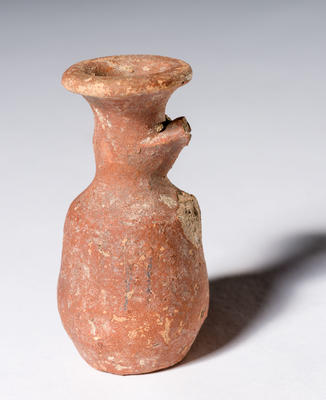Vessel, Juglet, red-slipped ware
Country
Cyprus
See full details
Object detail
Description
Juglet, red-slipped ware. Sack shaped body with wide slightly concave base. Cylindrical neck, swelling at mid point and widening to funnel shaped mouth with everted rim. Vertical arched handle from neck-ridge to shoulder, now missing. Buff brown clay with black grits and thick matt red brown slip, not well preserved. (Webb, Jennifer M., "Corpus of Cypriote Antiquities", Studies in Mediterranean Archaeology, Vol. XX: p. 8)
Classification
DOMESTIC EQUIPMENT Food and Drink Consumption jug
ARCHAEOLOGY Cypriot flask
ARCHAEOLOGY Cypriot flask
Production place
Measurements
L65mm x W35mm x D35mm
Media/Materials description
Buff brown clay with black grits and thick matt red brown slip, not well preserved.
History and use
Pottery is one of the most abundant, common and enduring artefacts in the ancient record, and one of human kinds most fundamental technologies. The craft or making pottery was widespread throughout the ancient world. Pottery was widespread as it was cheap to make, malleable into various forms and watertight after firing. Potters learnt the craft over several years – digging local clay, removing stones and roots, passing it through mesh, mixing with water and settling, cutting into squares, kneading to remove air pockets, forming the vessel, and firing. Vessels can be made using various methods, including pinch, coil, slab, paddle and anvil, and wheel or mould. It can be relatively plain, or decorated by using impressed designs, slips, paints, and even applying mould-made figures. Plain ware vessels are often under-reported in comparison to the more highly decorated vessels. Domestic pottery changed little in form and was largely undecorated – reflecting the ‘form and function’ approach and everyday utility of these vessels. This miniature version of a vessel may have been mass produced and used in votive contexts in early tombs in ancient Cyprus.
Associated person
Registration number
H664



